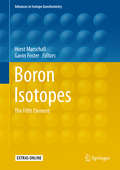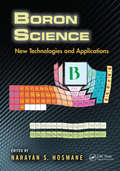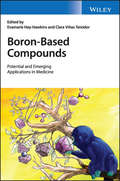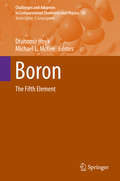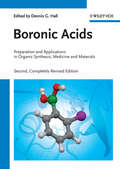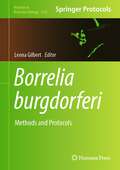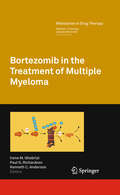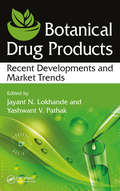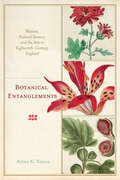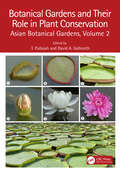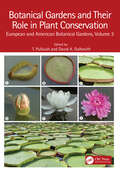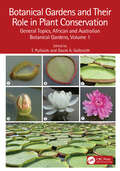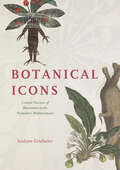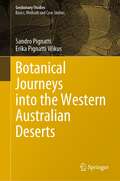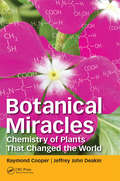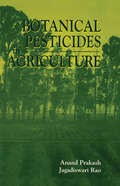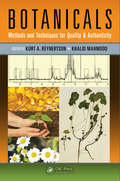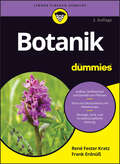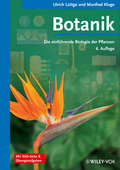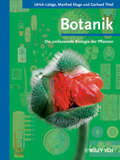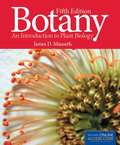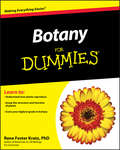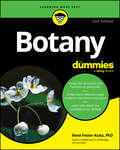- Table View
- List View
Boron Isotopes: The Fifth Element (Advances in Isotope Geochemistry)
by Horst Marschall Gavin FosterThis new volume on boron isotope geochemistry offers review chapters summarizing the cosmochemistry, high-temperature and low-temperature geochemistry, and marine chemistry of boron. It also covers theoretical aspects of B isotope fractionation, experiments and atomic modeling, as well as all aspects of boron isotope analyses in geologic materials using the full range of solutions and in-situ methods. The book provides guidance for researchers on the analytical and theoretical aspects, as well as introducing the various scientific applications and research fields in which boron isotopes currently play a major role. The last compendium to summarize the geochemistry of boron and address its isotope geochemistry was published over 20 years ago (Grew &Anovitz, 1996, MSA Review, Vol. 33), and there have since been significant advances in analytical techniques, applications and scientific insights into the isotope geochemistry of boron. This volume in the "Advances in Isotope Geochemistry" series provides a valuable source for students and professionals alike, both as an introduction to a new field and as a reference in ongoing research. Chapters 5 and 8 of this book are available open access under a CC BY 4. 0 license at link. springer. com
Boron Science: New Technologies and Applications
by Sergio A.B. da Fontoura Ricardo José Rocca José Félix Pavón MendozaBoron has made a significant impact in our lives through its quiet use in fertilizers, fungicides, soaps, detergents, and heat-resistant glassware. Boron Science: New Technologies and Applications addresses the applications of boron in chemistry, industry, medicine, and pharmacology by explaining its role in problems such as catalysis and hydrobora
Boron-Based Compounds: Potential and Emerging Applications in Medicine
by Evamarie Hey-Hawkins Clara Viñas TeixidorNoted experts review the current status of boron-containing drugs and materials for molecular medical diagnostics Boron-Based Compounds offers a summary of the present status and promotes the further development of new boron-containing drugs and advanced materials, mostly boron clusters, for molecular medical diagnostics. The knowledge accumulated during the past decades on the chemistry and biology of bioorganic and organometallic boron compounds laid the foundation for the emergence of a new area of study and application of boron compounds as lipophilic pharmacophores and modulators of biologically active molecules.This important text brings together in one comprehensive volume contributions from renowned experts in the field of medicinal chemistry of boron compounds. The authors cover a range of the most relevant topics including boron compounds as modulators of the bioactivity of biomolecules, boron clusters as pharmacophores or for drug delivery, boron compounds for boron neutron capture therapy (BNCT) and for diagnostics, as well as in silico molecular modeling of boron- and carborane-containing compounds in drug design. Authoritative and accessible, Boron-Based Compounds: Contains contributions from a panel of internationally renowned experts in the field Offers a concise summary of the current status of boron-containing drugs and materials used for molecular diagnostics Highlights the range and capacity of boron-based compounds in medical applications Includes information on boron neutron capture therapy and diagnostics Designed for academic and industrial scientists, this important resource offers the cutting-edge information needed to understand the current state of boron-containing drugs and materials for molecular medical diagnostics.
Boron: The Fifth Element (Challenges and Advances in Computational Chemistry and Physics #20)
by Drahomír Hnyk Michael L. MckeeThis multi-author edited volume reviews the recent developments in boron chemistry, with a particular emphasis on the contribution of computational chemistry. The contributors come from Europe, the USA and Asia. About 60% of the book concentrates on theoretical and computational themes whilst 40% is on topics of interest to experimental chemists. Specific themes covered include structure, topology, modelling and prediction, the role of boron clusters in synthetic chemistry and catalysis, as medical agents when acting as inhibitors of HIV protease and carbonic anhydrases.
Boronic Acids
by Dennis G. HallFollowing the huge success of the first edition, which has become THE reference source for everyone working in the field, this long-awaited, completely updated edition features almost 50% new content.The world-renowned chemist Prof Dennis Hall is joined by a select group of top authors to cover all modern aspects of boronic acid derivatives in one comprehensive handbook. The experimental procedures described make for extremely useful reading. From the reviews of the first edition: "...deserves to be on the bookshelf of all synthetic chemists, whether in discovery or process chemistry."
Borrelia burgdorferi: Methods and Protocols (Methods in Molecular Biology #2742)
by Leona GilbertThis volume covers the latest advancements and techniques used to understand the fastidious bacterium, Borrelia burgdorferi, and its significance in infectious disorders by combining both conventional and cutting-edge approaches. This book covers diverse topics, including direct detection, diagnostic methods, immune response analysis, alternative model systems, advanced proteomics, social media analysis, and clinical research. It also discusses unconventional wet lab research such as content analysis, the use of ChatGPT, clinical algorithms for chronic Lyme, establishment of a pregnancy Lyme disease biobank, and investigates Lyme in pregnant women. Written in the highly successful Methods in Molecular Biology series format, chapters include introductions to their respective topics, lists of the necessary materials and reagents, step-by-step, readily reproducible laboratory protocols, and tips on troubleshooting and avoiding known pitfalls.Cutting-edge and comprehensive, Borrelia burgdorferi: Methods and Protocols encompasses a wide range of techniques and caters to scientists from various disciplines and career stages, such as cell and molecular biologists, statisticians, and clinical researchers.
Bortezomib in the Treatment of Multiple Myeloma (Milestones in Drug Therapy)
by Kenneth C. Anderson Irene M. Ghobrial Paul G. RichardsonMultiple Myeloma (MM) is the second most common type of blood cancer, resulting from an overproduction of cancerous infection-fighting white blood cells, known as plasma cells. Plasma cells are a crucial part of the immune system responsible for the production of antibodies. Bortezomib is a promising anticancer drug targeting the proteasome. This proteasome inhibitor induces cell stress and apoptosis in the cancer cells. While multiple mechanisms are likely to be involved, proteasome inhibition may prevent the degradation of pro-apoptotic factors, permitting activation of programmed cell death in neoplastic cells dependent upon the suppression of proapoptotic pathways. This monograph on bortezomib is a valuable source of information for researchers and clinicians from the fields of oncology and pharmacology, working either in academia or the pharmaceutical industry.
Bose-Einstein Condensation in Dilute Gases
by C. J. Pethick H. SmithSince an atomic Bose-Einstein condensate, predicted by Einstein in 1925, was first produced in the laboratory in 1995, the study of ultracold Bose and Fermi gases has become one of the most active areas in contemporary physics. This book explains phenomena in ultracold gases from basic principles, without assuming a detailed knowledge of atomic, condensed matter, and nuclear physics. This new edition has been revised and updated, and includes new chapters on optical lattices, low dimensions, and strongly-interacting Fermi systems. This book provides a unified introduction to the physics of ultracold atomic Bose and Fermi gases for advanced undergraduate and graduate students, as well as experimentalists and theorists. Chapters cover the statistical physics of trapped gases, atomic properties, cooling and trapping atoms, interatomic interactions, structure of trapped condensates, collective modes, rotating condensates, superfluidity, interference phenomena, and trapped Fermi gases. Problems are included at the end of each chapter.
Bosnian Security after Dayton: New Perspectives (Contemporary Security Studies)
by Michael A. InnesFeaturing fresh contributions from leading scholars, this new volume considers a varied range of post-war, post-Dayton and post-9/11 problems and issues, reminding readers that Dayton is not the only challenge to the safety, stability, and long-term viability of the post-war Bosnian state. Drawing together all the latest research, this book covers new ground in its discussion of post-9/11 security concerns, and in its leading-edge analyses of crime, corruption, and terror in a transitional state. It takes Bosnia-Herzegovina seriously as a subject of regional and international affairs, and is a critically important contribution to scholarship, showing how redefined global security concerns have heavily altered international and domestic security priorities in Bosnia-Herzegovina, with corresponding implications for post-war justice and identity politics, foreign intervention, and state-level institution building. This is essential reading for scholars of the Balkans, peacebuilding and reconstruction, European politics and of security studies in general.
Botanical Drug Products: Recent Developments and Market Trends
by Yashwant Pathak Jayant LokhandeBotanicals, which have been part of human food and medicine for thousands of years, are perceived as being safer than synthetic pharmaceuticals. The global botanical drug market was expected to reach $26.6 billion by 2017. In terms of FDA regulations, botanical drugs are no different from non-botanical products, having to meet the safety and effectiveness standards of a new drug in accordance. This book comprises a complete start-to-end process from drug-idea conception, to drug development process. Key Features: Provides a complete compendium for botanical drug products Describes what BDP is and how it differs from Pharma, Biopharma, and Nutraceuticals Compiles all critical regulatory steps in a variety of countries Discusses clinical trial management for BDP development and how it differs from conventional chemical-based drugs and biopharmaceutics
Botanical Entanglements: Women, Natural Science, and the Arts in Eighteenth-Century England
by Anna K. SagalTo this day, women face barriers in entering scientific professions, and in earlier eras the challenges were greater still. But in Botanical Entanglements, Anna Sagal reveals how women’s active participation in scientific discourses of the eighteenth century was enabled by the manipulation of social and cultural conventions that have typically been understood as limiting factors. By taking advantage of the intersections between domesticity, femininity, and nature, the writers and artists studied here laid claim to a specific authority on naturalist subjects, ranging from botany to entomology to natural history more broadly.Botanical Entanglements pairs studies of well-known authors—Eliza Haywood, Charlotte Lennox, Maria Edgeworth, and Charlotte Smith—with authors and artists who receive less attention in this context—Priscilla Wakefield, Maria Jacson, Elizabeth Blackwell, Henrietta Maria Moriarty, and Mary Delany—to offer a nuanced portrait of the diverse strategies women employed to engage in scientific labor. Using socially acceptable forms of textual production, including popular periodicals, didactic texts, novels, illustrated works, craftwork, and poetry, these women advocated for more substantive and meaningful engagement with the natural world. In parallel, the book also illuminates the emotional and physical intimacies between women, plants, and insects to reveal an early precursor to twenty-first-century theorizing of plant intelligence and human-plant relationships. Recognizing such literary and artistic "entanglement" facilitates a more profound understanding of the multifaceted relationship between women and the natural world in eighteenth-century England.
Botanical Gardens and Their Role in Plant Conservation: Asian Botanical Gardens, Volume 2
by T. Pullaiah David A. GalbraithApproaching the contributions of a world-wide sector of scientific institutions to addressing the extinction crisis, Botanical Gardens and Their Role in Plant Conservation brings together a diversity of perspectives. There are more than 3,600 botanical gardens worldwide, where trees, shrubs, herbs, and other plants are studied and managed in collections. They are foremost among efforts to conserve the diversity of living plant species and ensure that crucial biodiversity is available for the future of humanity. This book is a showcase for plant conservation, restoration, biodiversity, and related scientific and educational work of botanical gardens around the world, featuring both thematic overview chapters and numerous case studies that illustrate the critical role these institutions play in fighting extinction and ensuring plant diversity is available for sustainable use. FEATURES A wide range of case studies derived from practical experience in a diversity of institutional, national, and biogeographical settings, Reviews of topics such as networking amongst institutions, the importance of global policy agreements such as the Convention on Biological Diversity and the Global Strategy for Plant Conservation, Profiles of botanical gardens contributions at the national level to conservation priorities, Real-world examples of programs in plant conservation for both critically endangered wild plant diversity and unique horticultural or cultural germplasm. Botanical Gardens and Their Role in Plant Conservation includes contributions from institutions from Africa, Asia, Australia, Europe, and the Americas, and institutions of all sizes and histories, from long-established national gardens to new gardens offering their perspectives on developing their roles in this vital undertaking.
Botanical Gardens and Their Role in Plant Conservation: European and American Botanical Gardens, Volume 3
by T. Pullaiah David A. GalbraithApproaching the contributions of a world-wide sector of scientific institutions to addressing the extinction crisis, Botanical Gardens and Their Role in Plant Conservation brings together a diversity of perspectives. There are more than 3,600 botanical gardens worldwide, where trees, shrubs, herbs, and other plants are studied and managed in collections. They are foremost among efforts to conserve the diversity of living plant species and ensure that crucial biodiversity is available for the future of humanity. This book is a showcase for plant conservation, restoration, biodiversity, and related scientific and educational work of botanical gardens around the world, featuring both thematic overview chapters and numerous case studies that illustrate the critical role these institutions play in fighting extinction and ensuring plant diversity is available for sustainable use. FEATURES A wide range of case studies derived from practical experience in a diversity of institutional, national, and biogeographical settings, Reviews of topics such as networking amongst institutions, the importance of global policy agreements such as the Convention on Biological Diversity and the Global Strategy for Plant Conservation, Profiles of botanical gardens contributions at the national level to conservation priorities, Real-world examples of programs in plant conservation for both critically endangered wild plant diversity and unique horticultural or cultural germplasm. Botanical Gardens and Their Role in Plant Conservation includes contributions from institutions from Africa, Asia, Australia, Europe, and the Americas, and institutions of all sizes and histories, from long-established national gardens to new gardens offering their perspectives on developing their roles in this vital undertaking.
Botanical Gardens and Their Role in Plant Conservation: General Topics, African and Australian Botanical Gardens, Volume 1
by T. Pullaiah David A. GalbraithApproaching the contributions of a world-wide sector of scientific institutions to addressing the extinction crisis, Botanical Gardens and Their Role in Plant Conservation brings together a diversity of perspectives. There are more than 3,600 botanical gardens worldwide, where trees, shrubs, herbs, and other plants are studied and managed in collections. They are foremost among efforts to conserve the diversity of living plant species and ensure that crucial biodiversity is available for the future of humanity. This book is a showcase for plant conservation, restoration, biodiversity, and related scientific and educational work of botanical gardens around the world, featuring both thematic overview chapters and numerous case studies that illustrate the critical role these institutions play in fighting extinction and ensuring plant diversity is available for sustainable use. FEATURES A wide range of case studies derived from practical experience in a diversity of institutional, national, and biogeographical settings, Reviews of topics such as networking amongst institutions, the importance of global policy agreements such as the Convention on Biological Diversity and the Global Strategy for Plant Conservation, Profiles of botanical gardens contributions at the national level to conservation priorities, Real-world examples of programs in plant conservation for both critically endangered wild plant diversity and unique horticultural or cultural germplasm. Botanical Gardens and Their Role in Plant Conservation includes contributions from institutions from Africa, Asia, Australia, Europe, and the Americas, and institutions of all sizes and histories, from long-established national gardens to new gardens offering their perspectives on developing their roles in this vital undertaking.
Botanical Icons: Critical Practices of Illustration in the Premodern Mediterranean
by Andrew GriebelerA richly illustrated account of how premodern botanical illustrations document evolving knowledge about plants and the ways they were studied in the past. This book traces the history of botanical illustration in the Mediterranean from antiquity to the early modern period. By examining Greek, Latin, and Arabic botanical inquiry in this early era, Andrew Griebeler shows how diverse and sophisticated modes of plant depiction emerged and ultimately gave rise to practices now recognized as central to modern botanical illustration. The author draws on centuries of remarkable and varied documentation from across Europe and the Mediterranean. Lavishly illustrated, Botanical Icons marshals ample evidence for a dynamic and critical tradition of botanical inquiry and nature observation in the late antique and medieval Mediterranean. The author reveals that many of the critical practices characteristic of modern botanical illustrations began in premodern manuscript culture. Consequently, he demonstrates that the distinctions between pre- and early modern botanical illustration center more on the advent of print, the expansion of collections and documentation, and the narrowing of the range of accepted forms of illustration than on the invention of critical and observational practices exclusive to modernity. Griebeler’s emphasis on continuity, intercultural collaboration, and the gradual transformation of Mediterranean traditions of critical botanical illustration persuasively counters previously prevalent narratives of rupture and Western European exceptionalism in the histories of art and science.
Botanical Journeys into the Western Australian Deserts (Geobotany Studies)
by Sandro Pignatti Erika Pignatti WikusThe book contains detailed descriptions of the unique desert environment with particular emphasis on vegetation and survival strategies of plants. Nine expeditions through the Southwest of Western Australia over a period of 15 years triggered the interest of the authors to explore also some deserts in the region, which leads to three further excursions into the sandy dunes of the desert. Observations of plant life in the deserts focused not only on identifying plants, but also on gaining some understanding of the aboriginal desert people of centuries past, and their own survival strategies in such extreme conditions. Also part of the Canning Stock Route was followed and explored, but the most rewarding and interesting finds were done criss-crossing the desert away from highways, tracks, and paths. The most remote areas showed species richness and surviving strategies which by far exceeded expectations.
Botanical Miracles: Chemistry of Plants That Changed the World
by Raymond CooperAs the shortcomings of purely synthetic approaches to biochemical discovery and development are becoming more apparent, a renaissance of interest in the chemistry of natural products as sources for new compounds is occurring. A unique approach to natural products chemistry, Botanical Miracles: Chemistry of Plants That Changed the World relates appl
Botanical Pesticides in Agriculture
by Anand Prakash Jagadiswari RaoDue to the prohibitive cost of synthetic pesticides and the problems of environmental pollution caused by continuous use of these chemicals, there is a renewed interest in the use of botanicals for crop protection. Agricultural entomologists, nematologists, and pathologists the world over are now actively engaged in research into the use of plants to fight agricultural pests and diseases, and to reduce the losses caused by them. Botanical Pesticides in Agriculture reviews the research on botanical pesticides used to combat losses due to pests of agricultural importance, with special attention focused on the use of higher plants. This book will serve as the baseline reference work for future research, and many of the botanicals discussed, such as neem, bael, begonia, pyrethrum, tobacco, karanj, and mahuwa, may become integral parts of pest control programs currently being developed. It is believed that botanical pesticides will minimize the undesirable side effects of synthetic pesticides and help preserve the environment for future generations.
Botanicals: Methods and Techniques for Quality & Authenticity
by Ian MuehlenhausThe international trade in plants is growing steadily as the worldwide demand for natural and botanical raw materials increases. Customers value natural products and botanicals as "green" alternatives-safer ingredients for their families which also represent an environmentally and socially responsible choice for the planet. In order to build assura
Botanik für Dummies (Für Dummies)
by Frank Erdnüß Rene Fester KratzVon der Wurzel bis zum Blatt – alles, was die Botanik zu bieten hat Mit diesem Buch verschaffen Sie sich ganz einfach einen umfassenden Überblick über die Botanik. Von den zellbiologischen Grundlagen über die verschiedenen Pflanzengewebe und -strukturen bis hin zu Physiologie, Genetik, Systematik und Ökologie: Jederzeit leicht verständlich vermittelt es Ihnen das nötige Basiswissen, das Sie in Ausbildung, Studium oder als botanisch interessierte Person benötigen. Themen wie Biodiversität, Biotechnologie, Einfluss von Klima, Agrar- und Forstwirtschaft oder die Bedeutung von Pflanzen für den Menschen runden das Buch ab. Sie erfahren Was die grundlegenden Prinzipien pflanzlichen Lebens sind Wie Pflanzen auf Umweltbedingungen reagieren und sich vermehren Wie Pflanzen systematisch eingeteilt werden Welche Schlüsselrolle Pflanzen im Ökosystem zukommt
Botanik: Die einführende Biologie der Pflanzen
by Ulrich Lüttge Manfred KlugeSeit fast 25 Jahren eines der erfolgreichsten einführenden Botanik-Lehrbücher! Mit seiner durchdachten Themenauswahl und anschaulichen Darstellung ist es der ideale Einstieg für alle, die Botanik, auch als Nebenfach, erfolgreich studieren wollen. Das Konzept: - Umfasst als einziges Kurzlehrbuch die gesamten Pflanzenwissenschaften - Themenkästen mit kompaktem Wissen, Methoden und Begriffserklärungen - Zusammenfassungen nach jedem Kapitel für leichteres Lernen und Wiederholen - Das ideale Lehrbuch für Botanik-Einsteiger Neu in der 6. Auflage: - Aktualisiert insbesondere in den Bereichen Zellbiologie, Genetik und Umweltfaktoren - Jetzt mit Kapiteln zu Biotechnologie und Bionik - Erstmals mit Übungsaufgaben und Lösungshinweisen - Zahlreiche neue Abbildungen; alle Abbildungen elektronisch für Studenten und Dozenten kostenlos verfügbar unter: www.wiley-vch.de/home/botanik
Botanik: Die umfassende Biologie der Pflanzen (Wiley-VCH-Lehrbuchkollektion 1)
by Ulrich Lüttge Manfred Kluge Gerhard ThielAs compact as possible and as comprehensive as necessary. The first edition of the "Lüttge/Kluge/Thiel" sets a new standard among German botany textbooks. It covers the entire field, from general and molecular basics right up to ecology and applications in biotechnology. The expert knowledge of the didactically experienced authors guides botany majors from the first semester of a bachelor degree right up to master's and beyond. Clear illustrations, chapter summaries, boxes on current research topics, glossaries and problems at the end of each chapter guarantee well-structured learning and perfect exam preparation - the best a textbook can offer. Website: WWW.WILEY-VCH.DE/HOME/BOTANIK
Botany (5th Edition)
by James D. MausethAs new information is introduced and environmental changes occur, Plant Biology continues to develop and evolve as a science. Updated and revised to keep pace with these developments, the Fifth Edition of Botany: An Introduction to Plant Biology provides a modern and comprehensive overview of the fundamentals of botany while retaining the important focus of natural selection, analysis of botanical phenomena, and diversity. Students are first introduced to topics that should be most familiar (plant structure), proceed to those less familiar (plant physiology and development), and conclude with topics that are likely least familiar to the introductory student (genetics, evolution, and ecology). Mauseth is sure to provide the latest material on molecular biology and plant biotechnology in an effort to keep pace with these advancing areas of study. All sections are written to be self-contained allowing for a flexible presentation of course material. Key Features: - Includes new content on molecular biology, plant biotechnology, and the most recent coverage of taxonomy and phylogeny of plants. - Now available with a new electronic laboratory manual. - Plants Do Things Differently boxes help students understand and compare plant biology with human biology. - End-of-chapter study guide includes nearly 50 or more questions in each chapter, urging students to test themselves on the most important points in the chapter. - Alternatives boxes encourage students to think expansively about alternative aspects of plant biology that are more advantageous in certain conditions.
Botany For Dummies
by Rene Fester KratzThe easy way to score your highest in botanyEmployment of biological scientists is projected to grow 21% over the next decade, much faster than the average for all occupations, as biotechnological research and development continues to drive job growth.Botany For Dummies gives you a thorough, easy-to-follow overview of the fundamentals of botany, helping you to improve your grades, supplement your learning, or review before a test. Covers evolution by natural selectionOffers plain-English explanations of the structure and function of plantsIncludes plant identification and botanical phenomenonTracking a typical course in botany, this hands-on, friendly guide is your ticket to acing this required course for your major in biology, microbiology, zoology, or elementary education.
Botany For Dummies
by Rene Fester KratzHarvest basic botany knowledge from this abundant book Botany For Dummies gives you a thorough overview of the fundamentals of botany, but in simple terms that anyone can understand. Great for supplementing your botany coursework or brushing up before an exam, this book covers plant evolution, the structure and function of plant cells, and plant identification. Plus, you'll learn about how plants of different types are changing and adapting in response to changing climates. This new edition goes into more detail on fungi—not technically plants, but no one is holding that against them. Regardless of what brought you to the wonderful world of botany, this book will show you around. Get an easy-to-understand introduction to the key concepts in botany Read about recent discoveries and theories in the world of plant science Understand different families of plants and where they grow Improve your grade and pass your exam in your introductory botany course Get a copy of Botany For Dummies and watch your botany knowledge bloom.
